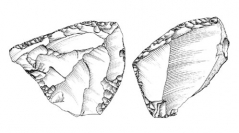

 Comptes Rendus Palevol
6 (4) - Pages 301-309
Comptes Rendus Palevol
6 (4) - Pages 301-309The analysis of key sites in Mediterranean France allows us to perceive important transformations within the last Neanderthalian societies, with a gradual rearticulation of the Mousterian technical systems around the production of blades and points, and with the upcoming of deep changes in the relationship of the craftsman with his tools. These industries have a chronological, territorial and cultural characterization that can be distinguished by an own appellation, the ‘Neronian’. Stratigraphically speaking, this MP/UP transitional group closes some main regional sequences. However, this ‘Neronian’ does not represent the end of the Middle Palaeolithic period in the Rhone valley. These very last Mousterian periods are marked by deep breakdowns of the traditional balances in the human groups, before the arrival of the first groups of Protoaurignacians such as we know them. This frame enlightens the parallelism between two historical paths, the Castelperronian in western and northern France and the Neronian in the Rhone valley. It also allows us to conceive the cultural and historical mosaic of human groups distinctive of the profound change at the end of the Middle Palaeolithic.
Final Middle Palaeolithic, cultures, techniques, evolutions, transitions, territories, initial Upper Palaeolithic, Mediterranean France, Neronian, Castelperronian, Protoaurignacian